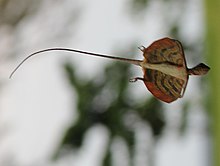Draco (lizard)
| Draco | |
|---|---|

| |
| D. taeniopterus in mid-glide, on Bulon Island, Thailand | |

| |
| Male D. spilonotus extending the dewlap (throat flap) and patagia ("wings") in Sulawesi, Indonesia | |
| Scientific classification | |
| Domain: | Eukaryota |
| Kingdom: | Animalia |
| Phylum: | Chordata |
| Class: | Reptilia |
| Order: | Squamata |
| Suborder: | Iguania |
| Family: | Agamidae |
| Subfamily: | Draconinae |
| Genus: | Draco Linnaeus, 1758 |
| Species | |
|
41 species (see text) | |

| |
Draco is a
While not capable of powered flight they often obtain lift in the course of their gliding flights. Glides as long as 60 m (200 ft) have been recorded, over which the animal loses only 10 m (33 ft) in height which makes for a
History of discovery
Distribution
Species of Draco are widely distributed in the forests of Southeast Asia, with one species, Draco dussumieri, inhabiting Southern India.[4]
Habitat and ecology
Members of Draco are primarily
Gliding


The lizards are well known for their "display structures" and ability to glide long distances using their
Life history
Draco lizards are
Phylogenetics
Within Agamidae, Draco is a member of the subfamily Draconinae. Within Draconinae, Draco is most closely related to the genera Japalura and Ptyctolaemus.[13]
Species



The following 41 species are recognized:[1][14]
- Draco abbreviatus Hardwicke & Gray, 1827 – Singapore flying dragon
- Draco beccarii W. Peters & Doria, 1878[15]
- Draco biaro Lazell, 1987 – Lazell's flying dragon
- Draco bimaculatus Günther, 1864 – two-spotted flying lizard
- Draco blanfordii Boulenger, 1885 – Blanford's flying dragon, Blanford’s flying lizard, Blanford's gliding lizard
- Draco boschmai Hennig, 1936
- Draco caerulhians Lazell, 1992
- Draco cornutus Günther, 1864
- Draco cristatellus Günther, 1872 – crested flying dragon
- Draco cyanopterus W. Peters, 1867
- Draco dussumieri A.M.C. Duméril & Bibron, 1837 – Indian flying lizard, Western Ghats flying lizard, southern flying lizard
- Draco fimbriatus Kuhl, 1820 – fringed flying dragon, crested gliding lizard
- Draco formosus Boulenger, 1900 – dusky gliding lizard
- Draco guentheri Boulenger, 1885 – Günther's flying lizard, Guenther's flying lizard
- Draco haematopogon Gray, 1831 – red-bearded flying dragon, yellow-bearded gliding lizard
- Draco indochinensis M.A. Smith, 1928 – Indochinese flying lizard, Indochinese gliding lizard
- Draco iskandari McGuire et al., 2007
- Draco jareckii Lazell, 1992
- Draco lineatus Daudin, 1802 – lined flying dragon
- Draco maculatus (Gray, 1845) – spotted flying dragon
- Draco maximus Boulenger, 1893 – great flying dragon, giant gliding lizard
- Draco melanopogon Boulenger, 1887 – black-bearded gliding lizard, black-barbed flying dragon
- Draco mindanensis Stejneger, 1908 – Mindanao flying dragon, Mindanao flying lizard
- Draco modiglianii Vinciguerra, 1892 – lined flying dragon
- Draco norvillii Alcock, 1895 – Norvill's flying lizard
- Draco obscurus Boulenger, 1887 – dusky gliding lizard
- Draco ornatus (Gray, 1845) – white-spotted flying lizard
- Draco palawanensis McGuire & Alcala, 2000
- Draco punctatus Boulenger, 1900 – punctate flying dragon
- Draco quadrasi Boettger, 1893 – Quadras's flying lizard
- Draco quinquefasciatus Hardwicke & Gray, 1827 – five-lined flying dragon, five-banded gliding lizard
- Draco reticulatus Günther, 1864
- Draco rhytisma Musters, 1983
- Draco spilonotus Günther, 1872 – Sulawesi lined gliding lizard
- Draco spilopterus Wiegmann, 1834 – Philippine flying dragon
- Draco sumatranus Schlegel, 1844 – common gliding lizard
- Draco supriatnai McGuire et al., 2007
- Draco taeniopterus Günther, 1861 – Thai flying dragon, barred flying dragon, barred gliding lizard
- Draco timoriensis Kuhl, 1820 – Timor flying dragon
- Draco volans Linnaeus, 1758 – common flying dragon
- Draco walkeri Boulenger, 1891
Nota bene: a binomial authority in parentheses indicates that the species was originally described in a genus other than Draco.
Similar prehistoric reptiles
See also
- Flying and gliding animals
- Chrysopelea gliding snake
References
- ^ a b Draco at the Reptarium.cz Reptile Database. Accessed 8 June 2021.
- ^ Greenwood Press[dubious].
- ^ PMID 21798987.
- S2CID 59043102.
- JSTOR 1446678.
- PMID 25540157.
- JSTOR 1439979.
- ^ PMID 29236777.
- S2CID 29494470.
- PMID 28179410.
- .
- doi:10.1111/bij.12319. "Similarly, in some Draco it has been suggested that females have larger heads for their body size than males to counterbalance an increased weight burden that is displaced posteriorly during gravidity."
- ISSN 0024-4082.
- ^ "Draco ". Dahms Tierleben. www.dahmstierleben.de.
- ISBN 978-1-4214-0135-5. (Draco beccarii, p. 21).
Further reading
- ISBN 0-7167-0020-4. (Genus Draco, pp. 41, 86, 112, 279, 288).
- Inger RF (1983). Morphological and ecological variation in the flying lizards (Genus Draco). Chicago: Field Museum of Natural History. (Fieldiana Zoology, New Series, No. 18). 33 pp.
- Linnaeus C (1758). Systema naturæ per regna tria naturæ, secundum classes, ordines, genera, species, cum characteribus, differentiis, synonymis, locis. Tomus I. Editio Decima, Reformata. Stockholm: L. Salvius. 824 pp. (Genus Draco, p. 199).
- Phillips, Walter Alison (1911). . Encyclopædia Britannica. Vol. 8 (11th ed.). pp. 466–468.
- Read on vastlyimportant
